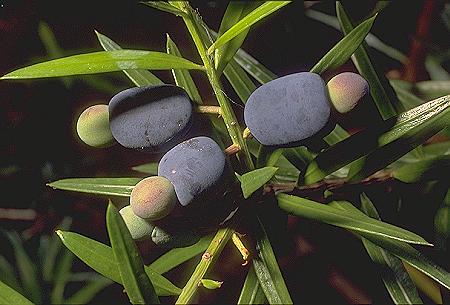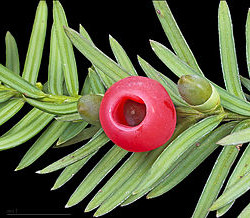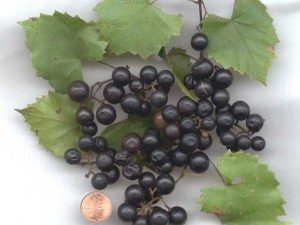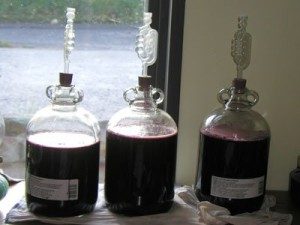
The fleshy Podocarpus arils are edible, but the hard seeds are not. Photo by Brian Walters
August locally means ripening Podocarpus fruit but remember to avoid the toxic seed. Extremely common as a hedge plant I have already touched upon the plant’s two major problems; no good common name and the toxic seed. What we eat is actually a fleshy aril that can be dark red to purple/black. The non-edible green seed is beside the aril. It’s light green with a blue powder on it that rubs off easily. When I say the seed is toxic it is not eat-one-seed drop dead toxicity like the Yew seed below left. The Podocarpus seed’s toxicity is low-grade and usually affects kids who eat the aril AND the seed though no one, adult or child, should eat the seed. This distinction needs to be made because the Yew tree — a totally separate species, Taxus, below and left — has a seed that is deadly and quickly so. It, too unwisely, is used in landscaping. To make matters worse the Podocarpus is sometimes called the Southern Yew, a name that I think should be totally avoided. You can read about the Podocarpus here.

The Yew seed, in the aril cup or not, is deadly.

Southern muscadine grapes, photo by Southern Matters.
As mentioned in last week’s newsletter our local grapes are ripening early this year, as much as four weeks in some places. Early to mid-September is the usual season. Our local muscadines are usually too acidic to make a smooth wine and have to have potassium carbonate or calcium cabonate added to reduce the acidity. The latter can add a chalky taste if you have too use too much to mellow it out. This year I am skipping the muscadine wine and experimenting with a fruit “wine,” specifically Podocarpus wine. I’m only going to make a gallon the first time out so if I make a huge error not much will be lost. Then again, if it turns out good there will be only four bottles of it.
Non-grape wines are usually easy to make. The recipes call for basically the same ingredients with only the volumes changing. Usually one checks for acid level, sugar levels then adds any if needed along with some grape tannin and some yeast nutriment to feed what ever yeast you use. When doing a test run it is best to kill of any wild yeast (and mold and vinegar bacteria) and use a

Elderberry wine by Stoneheadcroff.
commercial yeast which is inexpensive but guarantees a good performance. In this case I have been picking and freezing Podocarpus arils as convenient to have enough for a gallon batch (the seeds are toxic and are tossed away.) Actually, there are plenty of arils, I am just getting some here and some there as I find them. I could also try them to make wine but the flavor would more resemble sherry, not a favorite of mine. As the arils of the Podocarpus are mild so some additional acid was called for. In a year or two we’ll see how it came out, with updates along the way.
The amount of fruit needed to make five gallons of wine varies greatly. Ten pounds of elderberries will do nicely, but you need 22 pounds of pears (if you make a cider-like drink from pears it is called Perry.) Watermelon wine requires 18 pounds of pink flesh. I actually won a wine-tasting contest once with homemade watermelon wine. What was odd, however, is it stained my primary fermenter yellow but the finished wine was almost clear. Fruit wines is an option I consider when I get a windfall of some kind.
One of the benefits of teaching foraging to homeschool students is I get to hold classes during the week as opposed to just the weekend, and also hold them in some different places. There are also the gifts like the hand-made thank you card you see here. Everyone signed inside and I have it hanging on my wall. For this particular class we rummaged around in Melbourne for a few hours seeing everything from the tasty ground nut to the deadly water hemlock. We even managed to see some rare dandelions and picked out a lot of pawpaws. I’d like to thank the class again for inviting me over.
Holding foraging classes in the summer can be a challenge. Schools out, folks are on vacation, and it gets more than hot. It gets hot hot. I’ve had to cancel a Port Charlotte class twice because last-minute cancellations reduced the class to one or two for what is for me a 300 mile trip. But I’m game, I have that class rescheduled for a couple of weeks from now. We’ll be in September we should be able to hold it. Port Charlotte is a nice location with salt-tolerant plants and an interesting neighborhood next door to wander through. It is one of the class sites that has edible yams. Also this weekend I will hold a class in Cassadega at a fruitful little park which also has edible wild yams. Though it was a requested class site Cassadaga has never had large classes which is nice because it’s a pleasant change of pace. I will also hold a rare class in Wekiva State Park this weekend. I only do the Wekiva class once or twice a year for various reasons. The Wekiva is more the food that natives ate. Red Bug Slough Preserve is a hidden spot in Sarasota with quite a diversity of edibles and a recent addition to the class sites. Here’s the schedule for the next two weeks. For details on how to sign up for a class click here.
Saturday, August 24th, Colby-Alderman Park, 1099 Massachusetts Street, Cassadaga, Fl, 32706, 9 a.m.
Sunday, August 25th, Wekiva State Park, 1800 Wekiwa Circle, Apopka, Fl, 32712. 9 a.m.
Saturday, August 31, Red Bug Slough Preserve, 5200 Beneva Road, Sarasota, FL, 34233. 9 a.m.
Sunday, September 1st, 23157 Bayshore Live Oak Park, 23157 Bayshore Rd., Port Charlotte, FL 33980, 9 a.m.
My videos on DVDs are still doing well. Even though the same videos are for free on the internet some foragers like to have their own copy. The nine DVDs have 15 videos each, from 01 to 135, and come in nine cases each with a picture of yours truly on it. Some of them were enhanced from the version on the Internet. I print and compile the sets myself so if you have any issues I handle it personally. There are no middle men. To learn more about them click here.
And in the for what it’s worth department a Japanese/British team have developed what they say is a way to eat sunlight: An Algaculture Symbiosis Suit. It would allow the user to consume nutrients through a photosynthetic process. According to the team: Algaculture designs a new symbiotic relationship between humans and algae. It proposes a future where humans will be enhanced with algae living inside new bodily organs, allowing us to be semi-photosynthetic. Almost enabling us to become plant-like by gaining food from light. As such, we will be symbionts (meaning that both entities entirely depend on each other for survival), entering into a mutually beneficial relationship with the algae…”
Until the bugs are worked out, and there will be bugs, I think I’ll just forage.





I enjoyed your wine-making article.
However, I decided that it is a lot easier to make infused vodka with native fruits. Just wash the fruits, crush them a bit and drop them into vodka.
Yum. Better than all the artificially infused vodkas that are sold in liquor stores.
carol
Yes… but… a lot stronger than wine… more like a medicinal tincture (at least that what I tell the doctor!)
Is saw grass edible? Receipts?
Thanks,
geoff
There are many species called saw grass. Got a particular one in mind?
Can’t wait to pass this suggestion on to my father-in-law. He has several hundred feet of podocarpus hedge.
Years ago, when I took a wilderness survival class with John Street at Corbett WMA in Palm Beach County, he taught us to pull the sawgrass blade from the clump and eat the white part at the bottom. I didn’t know there was more than 1 type of sawgrass though.
I’ve made wines for many, many decades and I just use bread yeast because I also make bread. Thus far, the only tragedy was the year my banana wine exploded because I bottled it prematurely. My favorites have been sake, carrot wine, and pear wine. The worst was turnip wine. I read an article saying that the original brewer could hardly keep enough in the house. I believed her. If you like turnips that may be the case but mine, although “good” in measured terms, is/was soooo turnipy that I don’t think I’ll repeat the project.
Turnip wine… has to be on par with Pea Pod Wine. I won’t tell you what I made my worse batch out of but it up tasting like bacon, bad bacon…
I can’t believe it! A way to become semi-photosynthetic? I’m IN!! I thought about how great that would be when I was about 1/5 th my current age… and, just like the “Dick Tracy Watch” I pined for as a child and can have now but couldn’t way back then, it’s HERE!!! Thanks for that info!
Hello, does anyone have a recipe for podacarpus jelly? Or pie? My kids and I picked a bunch and now they are excited to make something from them 🙂
Blessings!